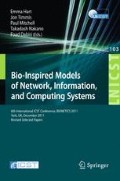Abstract
We present a bio-inspired mechanism that allows a peer-to-peer overlay network to adapt its topology in response to attacks that try to disrupt the overlay by targeting high-degree nodes. Our strategy is based on the diffusion of an “alert hormone” through the overlay network, in response to node failures. A high level of hormone concentration in a node induce that node to switch protocol. That leads to a self-organized modification of the entire overlay from a superpeer, scale-free layout, to a flatter network that is much less vulnerable to targeted attacks. As the hormone is metabolized with time, nodes switch back to the original protocol and reconstruct a superpeer overlay. We demonstrate and evaluate this mechanism on top of the peer-to-peer Myconet overlay, which is itself self-organized and bio-inspired.
Access this chapter
Tax calculation will be finalised at checkout
Purchases are for personal use only
Preview
Unable to display preview. Download preview PDF.
References
Yang, B., Garcia-Molina, H.: Designing a super-peer network. In: Proceedings of the 19th International Conference on Data Engineering (ICDE), p. 49 (2003)
Montresor, A.: A robust protocol for building superpeer overlay topologies. In: Proceedings of the 4th International Conference on Peer-to-Peer Computing, Zurich, Switzerland, pp. 202–209. IEEE (August 2004)
Gnutella Protocol Specification 0.6, http://rfc-gnutella.sourceforge.net
Liang, J., Kumar, R., Ross, K.W.: Understanding KaZaA. Polytechnic Univ. (2004) (manuscript)
Baset, S.A., Schulzrinne, H.: An analysis of the skype peer-to-peer internet telephony protocol. In: Proceedings IEEE INFOCOM 2006 25th IEEE International Conference on Computer Communications, vol. 6, pp. 1–11. IEEE (2004)
Liu, W., Yu, J., Song, J., Lan, X., Cao, B.: ERASP: An Efficient and Robust Adaptive Superpeer Overlay Network. In: Zhang, Y., Yu, G., Bertino, E., Xu, G. (eds.) APWeb 2008. LNCS, vol. 4976, pp. 468–474. Springer, Heidelberg (2008)
Snyder, P.L., Greenstadt, R., Valetto, G.: Myconet: A fungi-inspired model for superpeer-based peer-to-peer overlay topologies. In: SASO 2009, pp. 40–50 (2009)
Valetto, G., Snyder, P.L., Dubuois, D.J., Di Nitto, E., Calcavecchia, N.M.: A self-organized load-balancing algorithm for overlay-based decentralized service networks. In: SASO 2011 (2011)
Keyani, P., Larson, B., Senthil, M.: Peer pressure: Distributed Recovery from Attacks in Peer-to-Peer Systems. In: Gregori, E., Cherkasova, L., Cugola, G., Panzieri, F., Picco, G.P. (eds.) NETWORKING 2002. LNCS, vol. 2376, pp. 306–320. Springer, Heidelberg (2002)
Zweig, K.A., Zimmermann, K.: Wanderer between the worlds - self-organized network stability in attack and random failure scenarios. In: Second IEEE International Conference on Self-Adaptive and Self-Organizing Systems, SASO 2008, pp. 309–318. IEEE (2008)
Jelasity, M., Kowalczyk, W., Van Steen, M.: Newscast computing. Vrije Universiteit Amsterdam Department of Comp. Sci. Internal Report IR-CS-006 (2003)
Jelasity, M., Montresor, A., Jesi, G.P., Voulgaris, S.: The Peersim simulator, http://peersim.sf.net
Albert, R., Jeong, H., Barabási, A.L.: Error and attack tolerance of complex networks. Nature 406(6794), 378–382 (2000)
Van Mieghem, P., Doerr, C., Wang, H., Hernandez, J.M., Hutchison, D., Karaliopoulos, M., Kooij, R.E.: A framework for computing topological network robustness. Delft University of Technology, Report20101218 (2010), www.nas.ewi.tudelft.nl/people/Piet/TUDelftReports
Ghedini, C.G., Ribeiro, C.H.C.: Rethinking failure and attack tolerance assessment in complex networks. Physica A: Statistical Mechanics and its Applications (2011)
Chan-Tin, E., Feldman, D., Hopper, N., Kim, Y.: The Frog-Boiling Attack: Limitations of Anomaly Detection for Secure Network Coordinate Systems. In: Chen, Y., Dimitriou, T.D., Zhou, J. (eds.) SecureComm 2009. LNICST, vol. 19, pp. 448–458. Springer, Heidelberg (2009)
Yue, X., Qiu, X., Ji, Y., Zhang, C.: P2p attack taxonomy and relationship analysis. In: 11th International Conference on Advanced Communication Technology, ICACT 2009, vol. 02, pp. 1207–1210 (February 2009)
Srivatsa, M., Liu, L.: Vulnerabilities and security threats in structured overlay networks: A quantitative analysis. In: Computer Security Applications Conference, Annual, pp. 252–261 (2004)
Perlegos, P.: Dos defense in structured peer-to-peer networks. Computer (2004)
Samant, K., Bhattacharyya, S.: Topology, search, and fault tolerance in unstructured p2p networks (2004)
Turing, A.M.: The chemical basis of morphogenesis 237(641), 37–72 (1952)
Balasubramaniam, S., Botvich, D., Donnelly, W., Foghlú, M.Ó., Strassner, J.: Biologically inspired self-governance and self-organisation for autonomic networks. In: Proceedings of the 1st International Conference on Bio Inspired Models of Network, Information and Computing Systems, BIONETICS 2006. ACM, New York (2006)
Trumler, W., Thiemann, T., Ungerer, T.: An artificial hormone system for self-organization of networked nodes (2006)
Poor, R.D.: Embedded Networks: Pervasive, Low-Power, Wireless Connectivity. PhD thesis, Massachusetts Institute of Technology, School of Architecture and Planning, Program in Media Arts and Sciences (2001)
Intanagonwiwat, C., Govindan, R., Estrin, D.: Directed diffusion: A scalable and robust communication paradigm for sensor networks. In: Proceedings of the 6th Annual International Conference on Mobile Computing and Networking, pp. 56–67. ACM (2000)
Author information
Authors and Affiliations
Editor information
Editors and Affiliations
Rights and permissions
Copyright information
© 2012 ICST Institute for Computer Science, Social Informatics and Telecommunications Engineering
About this paper
Cite this paper
Snyder, P.L., Osmanlioglu, Y., Valetto, G. (2012). Biologically Inspired Attack Detection in Superpeer-Based P2P Overlay Networks. In: Hart, E., Timmis, J., Mitchell, P., Nakamo, T., Dabiri, F. (eds) Bio-Inspired Models of Networks, Information, and Computing Systems. BIONETICS 2011. Lecture Notes of the Institute for Computer Sciences, Social Informatics and Telecommunications Engineering, vol 103. Springer, Berlin, Heidelberg. https://doi.org/10.1007/978-3-642-32711-7_8
Download citation
DOI: https://doi.org/10.1007/978-3-642-32711-7_8
Publisher Name: Springer, Berlin, Heidelberg
Print ISBN: 978-3-642-32710-0
Online ISBN: 978-3-642-32711-7
eBook Packages: Computer ScienceComputer Science (R0)

